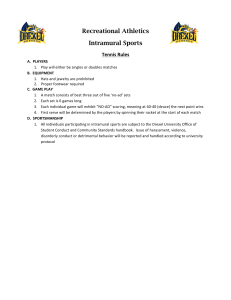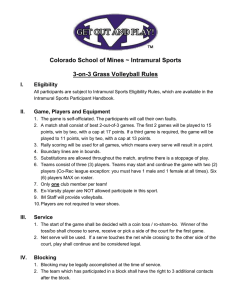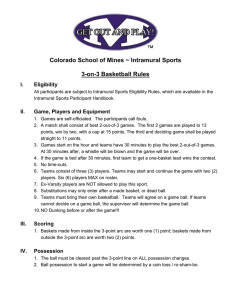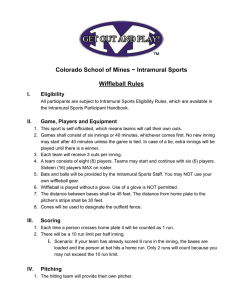West Chester University Department of Campus Recreation Intramural Wiffleball Rules
advertisement
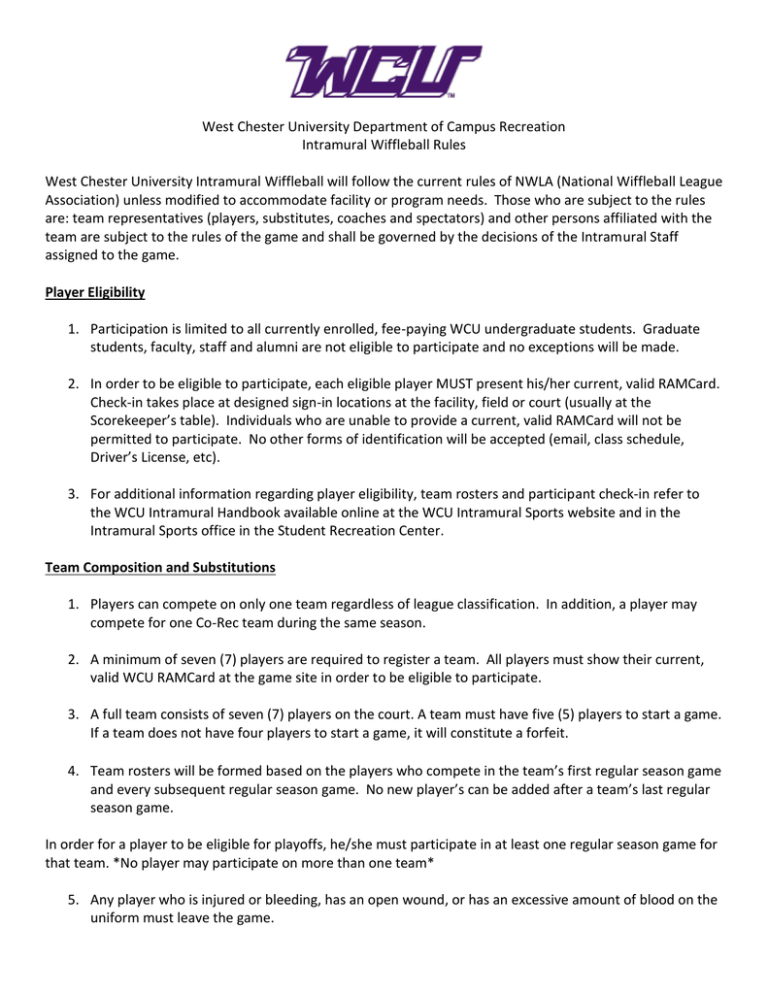
West Chester University Department of Campus Recreation Intramural Wiffleball Rules West Chester University Intramural Wiffleball will follow the current rules of NWLA (National Wiffleball League Association) unless modified to accommodate facility or program needs. Those who are subject to the rules are: team representatives (players, substitutes, coaches and spectators) and other persons affiliated with the team are subject to the rules of the game and shall be governed by the decisions of the Intramural Staff assigned to the game. Player Eligibility 1. Participation is limited to all currently enrolled, fee-paying WCU undergraduate students. Graduate students, faculty, staff and alumni are not eligible to participate and no exceptions will be made. 2. In order to be eligible to participate, each eligible player MUST present his/her current, valid RAMCard. Check-in takes place at designed sign-in locations at the facility, field or court (usually at the Scorekeeper’s table). Individuals who are unable to provide a current, valid RAMCard will not be permitted to participate. No other forms of identification will be accepted (email, class schedule, Driver’s License, etc). 3. For additional information regarding player eligibility, team rosters and participant check-in refer to the WCU Intramural Handbook available online at the WCU Intramural Sports website and in the Intramural Sports office in the Student Recreation Center. Team Composition and Substitutions 1. Players can compete on only one team regardless of league classification. In addition, a player may compete for one Co-Rec team during the same season. 2. A minimum of seven (7) players are required to register a team. All players must show their current, valid WCU RAMCard at the game site in order to be eligible to participate. 3. A full team consists of seven (7) players on the court. A team must have five (5) players to start a game. If a team does not have four players to start a game, it will constitute a forfeit. 4. Team rosters will be formed based on the players who compete in the team’s first regular season game and every subsequent regular season game. No new player’s can be added after a team’s last regular season game. In order for a player to be eligible for playoffs, he/she must participate in at least one regular season game for that team. *No player may participate on more than one team* 5. Any player who is injured or bleeding, has an open wound, or has an excessive amount of blood on the uniform must leave the game. 6. Substitutions can only be made between innings. Equipment and Playing Field 1. Wiffleballs and bats are not available for check-out at the Student Recreation Center. The Campus Recreation Staff will provide game balls and bats. Teams are responsible for any damage to game equipment during warm-ups. 2. Teams are encouraged to wear their own like-colored jerseys. Scrimmage vests (pinnies) are available for checkout at the courts. 3. Individual Player Equipment must meet the following requirements: a. Shirts: Shirts must be worn throughout the game. Shirts must not have arm openings that are larger than four inches. Referees will measure the arm openings with their fist. Shirts that have been altered and are missing more than the length of the sleeve will not be permitted. b. Pants: Players may not wear pants or shorts that have belt loops, metal, cargo pockets or exposed drawstrings. Players may not wear towels that hang from the waist. c. Headgear: Baseball caps or other rigid headwear is not permitted. Players may wear rubber or cloth elastic headbands that are used to control hair. Bandanas with knots are prohibited. d. Pads or Braces: No pads or braces may be worn above the waist. Leg and knee braces made of hard, unyielding material must be covered on both sides and all edges with slow-recovery padding. e. Shoes: All players must wear shoes. Athletic/Tennis shoes are permitted. Any other type of shoe that the official deem unsafe is prohibited. 4. Jewelry is NOT allowed to be worn by any participant during the game. Jewelry consists of visible rings (wedding bands), watches, necklaces, earrings, studs (including tongue or lip rings), bracelets (metal or cloth) and any other such similar jewelry. Medical alert bracelets must be taped to the body or secured under clothing such as a sock to be worn during play. Taping of any other forms of jewelry, other than a medical bracelet, is prohibited. Players are subject to ejection for failure to remove jewelry. 5. Games will take place on the basketball court in Hollinger Field House. a. The playing field will be within the basketball court boundary lines. b. The pitcher’s mound will be placed between the free throw line and 3 pt. arc. c. Distance between bases will be approx. 45 feet. d. A chair will be used as the strike zone. Game Timing 1. Game time is forfeit time. Any team that forfeits a game can jeopardize any playoff potential due to a low sportsmanship rating. Teams who forfeit more than once will be dropped from the league. 2. Each game has a 45-minute or 9 inning limit. Any inning started before the end of the 45-minute time period will be completed. No innings will begin after 45 minutes. 3. Regular season games can end in a tie. Extra innings will be played only if they start before the 45minute time limit. All tournament games will continue until a winner is determined. Scoring 1. There is a 10 run-limit per inning for each team. Once the 10th run is scored, the inning will end no matter how many outs. 2. A homerun will be awarded if a batted ball travels over the right field bleachers or hits the championship banners in left field in the air. 3. (Mercy Rule) If a team is up by 15 or more runs after the 5th inning the game will end. Pitching 1. Defensive teams will pitch to the opposing team on offense. 2. In the act of delivering the ball to the batter, the pivot foot must remain in contact with the pitcher’s mound until the ball leaves the pitcher’s hand. 3. A legal delivery shall be a ball that is delivered underhand or overhand at a moderate (lob) speed. a. Pitchers will be permitted to throw one “fast” pitch per at bat. 4. A called strike will be determined by a pitched ball hitting any of the plastic part of the seat. a. The metal legs of the chair are not part of the strike zone. 5. The pitcher has 10 seconds between pitches. If he/she exceeds this time, an automatic ball will be called. 6. Teams are required to change pitchers every inning. Pitchers are permitted to pitch in multiple innings provided the innings are not back-to-back. Batting 1. The batter must keep two hands on the bat prior to and when contacting the ball. One-handed swings are not permitted. 2. Batted balls must travel at least 10 feet to be considered a fair ball. a. Bunting is not permitted 3. The ceiling is in play and balls that hit off the ceiling will be considered live with exception of the scoreboard. a. A ball that makes contact with the ceiling and is caught will be considered an out. b. Batted balls that hit the scoreboard will be considered a foul ball. 4. Batters start with a normal 0 balls and 0 strikes count. Batters may walk on 4 balls or strike out on swinging or called 3rd strikes. If a batter fouls on their 3rd strike, he/she will be out. a. If a batter hits the scoreboard with 2 strikes, it will not count as a 3 rd strike and the batter will receive another pitch. 5. In the event that a player is on base when it is their turn to bat, the player shall be relieved by another team member allowing him/her to bat. Running 1. Runners cannot lead off or steal bases. Base runners may leave the base when the pitch is contacted by the batter. 2. Runners are not allowed to slide. Any runner who slides will be declared out. 3. The base path for a runner is a direct line between the player and the base to which he/she is running at the time a play is being made on that specific base runner and the three feet to either side of that direct path. a. The exemption is if a base runner is advancing for multiple bases. Base runners may take a more rounded path to maintain their speed, providing they maintain their established path b. For plays between home plate and 1st base, base runners are encouraged to run on the foul side towards 1st base. 4. A base runner who runs outside (more than 3-feet) his/her established base path in order to avoid a tag shall be declared out. 5. Base runners must avoid all collisions with fielders anytime a fielder is making a play on the ball. Any base runner who does not avoid the collision will be ruled out; he/she will be ejected immediately. The batter will be awarded 1st base and runners will return to their original base unless forced to the next base. (If a runner occupies 1st he/she will be awarded 2nd so the batter can be awarded 1st) 6. Defensive players may not intentionally stand or obstruct the base path of a base runner unless he/she is fielding the ball. If a defensive player intentionally obstructs a base runner, the umpire shall award that base runner and all others the bases they would have reached had there been no obstruction. a. Obstruction is also called when a fielder without the ball fakes a tag in which the umpire will award bases as a normal obstruction and eject the fielder from the game. 7. A runner who is in fair territory and not in contact with a base that is struck by a batted ball will be declared out except if: a. The ball has passed an infielder and no other fielder had a chance to make a play b. A runner is hit with a fair batted ball in foul territory and no other fielder could make a play c. A runner is touched by the ball after it is touched by any fielder If an exception occurs, all runners must return to the base they originally occupied and the batter is awarded first base unless forced to the next base. 8. Base runners may not attempt to jump over, hurdle or intentionally collide with a defensive player in possession of the ball attempting to make a tag on the base runner. Players who violate this rule will be ruled out, ejected and base runners will return to the original base they occupied. 9. Courtesy or pinch runners are not allowed in wiffleball. Fielding 1. Each team must provide a pitcher. There are no other defensive restrictions. 2. The offensive team is responsible for helping to retrieve pitched balls not hit to return to the pitcher. 3. The batter and runner/s are out in all situations similar to softball: fly-out, force-out and tag-out. a. Runners can also be put out if he/she is hit directly with a thrown ball below the shoulders. If the ball bounces the runner shall be safe. b. Mounding – Only the batter running to 1st base can be put out if the ball is returned to the pitcher while in contact with the mound, before the runner can reach 1st base. Only one runner can be declared out in mounding situations. 4. There is no infield fly rule. 5. 3 defensive outs will end the half of the inning. 6. The ceiling and bleachers are in play and balls that hit off them will be considered live with exception of the scoreboard. a. A ball that makes contact with the ceiling and is caught will be considered an out. b. A ball that makes contact with the right field bleachers and is caught will not be an out, but play will remain live. c. Batted balls that hit the scoreboard will be considered a foul ball. Co-Rec Modifications 1. A team is composed of seven (7) players. Play may start with no less than five (5) players. A team may also play with 6 players. At no time may there be 2 more players of one gender over the other on the field for a team. Therefore, the only legal combinations are 4 males + 3 females, 3 males + 4 females, 3 males + 3 females, 3 males + 2 females, or 2 males + 3 females. Substitutions may only take place as a male for male or female for female. 2. Pitchers must alternate gender each inning. Pitchers are permitted to pitch multiple innings. Sportsmanship 1. The Sportsmanship Rating System is intended to be an objective scale by which teams' attitude and behavior can be assessed throughout the intramural sports league and playoff seasons. Behavior before, during, and after an intramural sports contest is included in the rating. The team captain is responsible for educating and informing all players and spectators affiliated with his/her team about the system. 2. A team is responsible for the actions of the individual team members and spectators related to it. Additionally, WCU Intramural Sports does not recognize the use of coaches. Only the team captain shall speak to the officials regarding administrative matters (ejections, disqualifications, etc). Furthermore, the team captain's efforts in assisting Intramural Staff to calm difficult situations and to restrain troubled teammates are key to controlling team conduct. 3. Sportsmanship is vital to the conduct of every Intramural contest. In order to encourage proper conduct during games, officials, administrative personnel, and supervisors shall make decisions on whether to warn, penalize or eject players or teams for poor sportsmanship. These decisions are final. The Intramural Sports administrative staff will rule on further penalties as a result of unsportsmanlike conduct. 4. Each participant should choose his or her team members carefully, as all team members will suffer the consequences of any disciplinary action taken by the Intramural Sports staff against that team for violation of the intramural rules and sportsmanship guidelines. Protests or appeals of sportsmanship ratings will not be recognized. The Intramural Sports administrative staff reserves the right to review any rating given to a team. 5. Additional information regarding team and participant sportsmanship including the rating method, factors, and scale is available in the Intramural Sports Handbook, available online at the WCU Campus Recreation web site.
